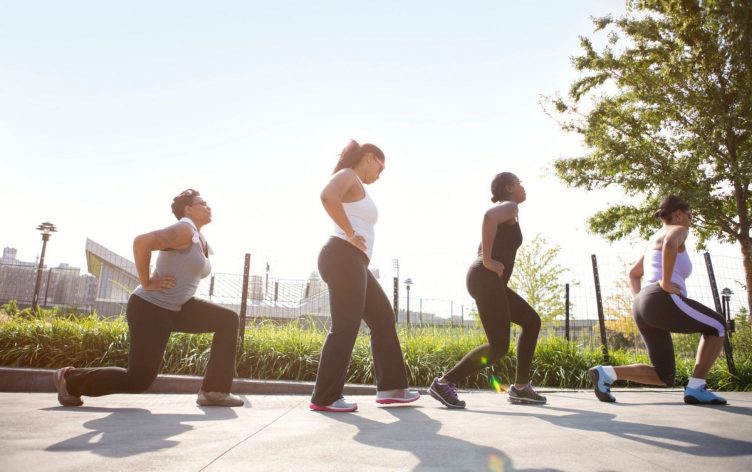
When you’re looking for a new gym or group classes — or even a personal trainer — being larger can make you feel self-conscious and sometimes unwelcome, says trainer Morit Summers.
“I’m a plus-size woman, and have been my entire life, but I also work out,” she notes. “Having been in the fitness industry for 14 years, I know how it feels not to fit in, or like you don’t belong in a space because of your size.” That’s what led her to start her own gym, Form Fitness in Brooklyn, New York.
Apart from spending time in each gym you’re considering, how can you tell if one space is more size-inclusive than another? Summers and other trainers at body-positive gyms offer these five tips for finding what fits best for you:
1
CHECK OUT SOCIAL MEDIA AND MARKETING IMAGES
Take some time to scroll through a gym’s social media posts and pay attention to what they highlight. You can often get a good feel for the type of people who attend its classes or work out there, and you can find out if there’s a level of enthusiasm based on comments to those posts.
Even if a gym boasts being body positive, the images it uses might convey a different strategy, says Jessica Fuller, owner of The Hot Yoga Spot and CrossFit for the People in upstate New York. Both were created to offer an inviting, safe atmosphere for everyone — beginners, those with chronic pain issues, people who are overweight and obese, and those recovering from injuries.
“The photos we put up of our students represent who works out here, not some super fit ideal or unattainable goal in terms of body size,” says Fuller. “There are people of different sizes, different abilities, different shapes, and we embrace that. When you look at images used to promote your gym, you should feel represented.”
2
LISTEN DURING CLASS OBSERVATION
Just as images can give you subtle signs about feeling welcome, hearing the kind of messages teachers and trainers call out can do the same, Fuller says.
For instance, hearing a teacher shout about burning more calories and getting bikini ready isn’t necessarily a bad thing — but it might not be your thing, especially if it makes you feel uncomfortable or left out. You should leave a class feeling encouraged and motivated, not shamed in any way.
3
ASK ABOUT GOAL SETTING
Particularly if you’re interviewing personal trainers, asking about a fitness plan should always come with talking about goals. If a trainer assumes your only interest is losing weight, it’s likely not a good fit, even if that is part of your larger set of goals.
“Talk about what would make exercise enjoyable for you, what your strengths are, what excites you,” suggests Kira Macoun, trainer and co-founder of Comfy Fitness in Chicago. “Your goals should not feel like they’re being put in place as punishment. That’s never going to work. You should feel happy about coming in to work out, so make your goals into realistic milestones that fit your life.”
For example, rather than “I want to lose 50 pounds,” she suggests goals like, “I want to be able to play with my kids at the playground for an hour,” or “I want to shovel my own walkway without having to stop for breaks every few feet.” Non-scale goals like that make you feel strong and capable.
“Unfortunately, the fitness industry has been very successful at making everything about how much weight you can lose,” says Macoun. “That makes you miss out on feeling grateful about how much your body can do already, and how much more you can do when you work on it.”
4
MAKE SURE THERE ARE MODIFICATIONS
If you’re a beginner, there are likely moves you may not be able to do — at least not right away. There are so many options when it comes to working out that a gym should always be able to offer several different choices to modify an activity for you.
“You should never be left to figure it out on your own,” says Macoun. “After all, isn’t that why you’re at the gym, to get a certain level of expertise?” She adds that the environment should feel welcoming enough that you’re comfortable asking for modifications, rather than embarrassed to make the request.
5
LOOK FOR OTHER SIGNS OF INCLUSION
At Fuller’s CrossFit for the People, someone who’s obese might be working out next to someone with a prosthetic limb, rheumatoid arthritis or who’s elderly and dealing with osteoporosis. Yet, everyone is challenging themselves and cheerleading for each other.
Gyms and classes that are body-positive aren’t just about size, they’re about bodies and how each person can work around their limitations. Being in a space where there’s a diversity of ages, capabilities and conditions can be helpful for making everyone feel part of a space, Fuller says.
“Everyone deserves the opportunity to feel better and move better,” she notes. “It can be powerful to find a place like that, because it will inspire you to do more.”







